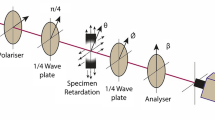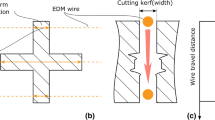Abstract
The moiré fringe multiplication method which used interference of the +1st and -1st order diffracted beams from a 1000 lines/mm phase-type grating on the specimen surface was applied to the measurement of strain distribution at the tip of a propagating fatigue crack in a steel plate having a central crack. The sensitivity of the measurement was equivalent to the sensitivity obtained from a 2000 lines/mm grating on the specimen when the conventional moiré fringe method is used. The gage length was of the order of 10μm. The result of the measurement of strain distribution was applied to the estimation of the fatigue crack propagation rate.
Résumé
La méthode de multiplication des franges de Moiré qui utilise les interférences d'ordre +1 et -1 de rayons lumineux diffractés par une grille de 1000 lignes/millimètre, du type “à phase” sur la surface de l'éprouvette, a été appliqué à la mesure de la distribution des déformations à l'extrémité d'une fissure de fatigue en cours de propagation dans une tôle d'acier présentant une fissure centrale.
La sensibilité de la mesure était équivalente à la sensibilité obtenue par une grille de 2000 lignes/millimètre appliquée sur l'éprouvette et utilisant la méthode de franges de Moiré conventionnelle. La longueur de référence était de l'ordre de 10 microns. Le résultat des mesures de distribution de déformation a été appliqué à l'estimation de la vitesse de propagation d'une fissure de fatigue.
Similar content being viewed by others
References
G.T. Hahn, R.G. Hoagland, and A.R. Rosenfield, Metallurgical Transactions, 3 (1972) 1189–1202.
T.S. Kang, H.W. Liu, International Journal of Fracture, 10 (1974) 201–222.
Y. Iino, Engineering Fracture Mechanics, 7 (1975) 205–218.
S. Taira and K. Tanaka, Microscopic Study of Fatigue Crack Propagation in Carbon Steels, Mechanical Behavior of Materials, Proceedings of International Conference on Mechanical Behavior of Materials, II, Society of Materials Science, Japan, (1972) 48–58.
A. Ohta and E. Sasaki, Acta Metallurgica, 20 (1972) 657–660.
S. Nishijima, Transactions of the Japan Society of Mechanical Engineers, 32–242 (1966) 1464–1469, in Japanese andTransactions of National Research Institute for Metals, 11–1 (1969) 59–66.
M. Kikukawa, M. Jono, K. Yasui, M. Adachi, and Y. Inada, Journal of Materials Science, Japan, 23 (1974) 708–715, in Japanese.
Y. Shirota and H. Miyamoto, Measurement of the Depression around the Crack by the use of Optical Interference, Preprint of the Japan Society of Mechanical Engineers, 198 (1973) 1–4, in Japanese.
D. Post, Experimental Mechanics, 8–2 (1968) 63–68.
K. Kato, F. Yamamoto, T. Murota, and K. Jinba, Transactions of the Japan Society of Mechanical Engineers, 39 (1973) 546–555, in Japanese.
K. Matsumoto and M. Takashima, Applied Optics, 12 (1973) 858–864.
M. Siratori, T. Miyoshi, and M. Miyamoto, Analysis of Fatigue Crack Propagation and Phenomena of Closure, Preprint of the Japan Society of Mechanical Engineers, 760, 2 (1975) 197–209, in Japanese
W. Elber, The Significance of Fatigue Crack Closure, Damage Tolerance in Aircraft Structures, American Society for Testing and Materials, Special Technical Publication, 486 (1971) 230–242.
H. Nisitani, and K. Takao, Engineering Fracture Mechanics, 6 (1974) 253–260.
M. Kikukawa, M. Jono, K. Tanaka and M. Takatani, Journal of Materials Science, Japan, 25 (1976) 899–903, in Japanese.
A. Ohta and E. Sasaki, International Journal of Fracture, 11 (1975) 1049–1051.
K. Ohji, K. Ogura, and Y. Ohkubo, Engineering Fracture Mechanics, 7 (1975) 457–464.
S. Majumdar, and J. Morrow, Correlation between Fatigue Crack Propagation and Low Cycle Fatigue Properties, Fracture Toughness and Slow-Stable Cracking, American Society for Testing and Materials, Special Technical Publication, 559 (1974) 159–182.
S. Matsuoka, and K. Tanaka, private communication.
A. Ohta, and E. Sasaki,Engineering Fracture Mechanics, in press.
Author information
Authors and Affiliations
Rights and permissions
About this article
Cite this article
Ohta, A., Kosuge, M. & Sasaki, E. Measurement of strain distribution by the moiré fringe multiplication method at a tip of propagating fatigue crack. Int J Fract 13, 289–300 (1977). https://doi.org/10.1007/BF00040145
Received:
Issue Date:
DOI: https://doi.org/10.1007/BF00040145




